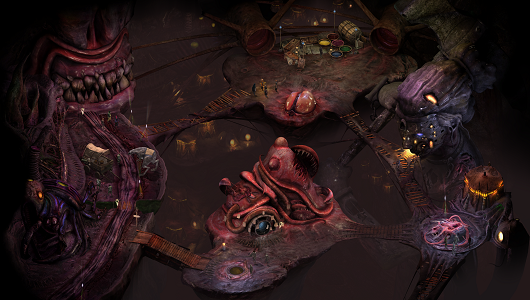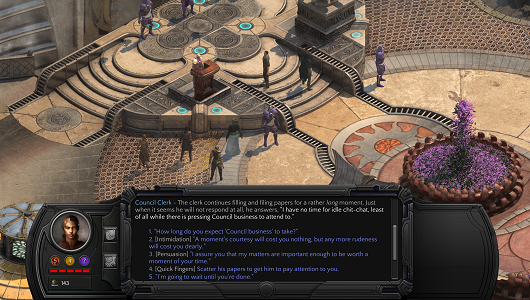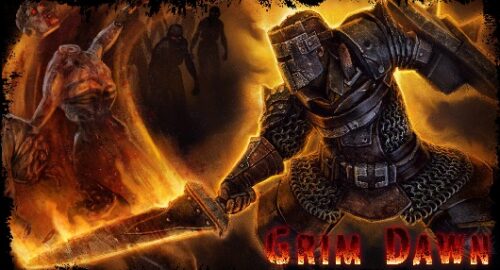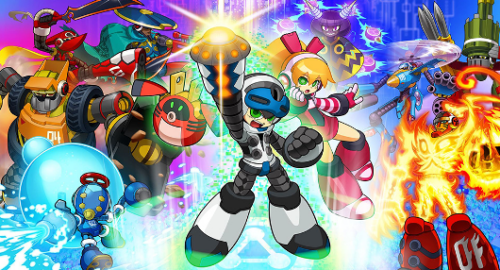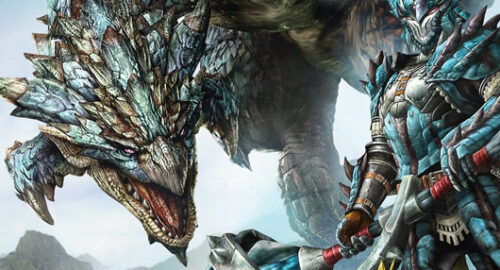What does one life matter? That is the question at the heart of Torment: Tides of Numenera. It’s a question seared into the very bones of the game and every quest you embark on, every horror you face, every triumph and every tragedy brings you once step closer to answering it. inXile Entertainment promised fans of Planescape: Torment a worthy spiritual successor and they have delivered.
It has been almost two decades since the release of Planescape: Torment. Ever since then fans have been desperate for a new game to fill the void left by one of the greatest CRPG’s of all time while also being skeptical that anything could ever compare to the original. Whereas other games from the glory days of the Infinity Engine and isometric CRPG’s were typically rooted firmly in conventional D&D/LOTR high fantasy or post-apocalyptic sci-fi, Planescape: Torment often used elements more commonly found in the horror genre. Its writing was as good or better (if you ask me) as anything the more mainstream and lauded Baldur’s Gate series ever put forth. If the combat in the original had been better I would say that Planescape: Torment was the best CRPG of its time. That game asked “What can change the nature of a man?” and that question served as the anchor for the entire game just as the question “What does one life matter?” does in its successor; Torment: Tides of Numenera.
• Developer: inXile Entertainment
• Publisher: Techland
• Reviewed on: PC
• Also Available On: Mac, Linux, Xbox One & Playstation 4
• Release Date: February 28, 2017

[youtube id=”V7QKH891Huc” align=”center” mode=”normal” autoplay=”no” maxwidth=”530″]
Players certainly don’t need to have played a game that came out in 1999 in order to enjoy Torment: Tides of Numenera. The two games share a lot of DNA but are also very, very different in terms of mechanics and both have their own self-contained story that stands alone. That said, picking up Planescape: Torment off of GOG is money well spent and anyone who still owns an original copy should play the game again, before or after playing Torment: Tides of Numenera.
The game is beautiful to look at thanks in large part to inXile Entertainment’s deal with Obsidian Entertainment that allowed them to build the game using a lot of the tech used to create Pillars of Eternity. Of course, you have to have an appreciation for the isometric view but the varied environments and characters in Torment: Tides of Numenera look equal parts gorgeous and horrifying (in a good way). Assets are not reused and each location is unique. The game is only semi-open, meaning once you leave a major location you cannot backtrack. However, the games two main hubs (the rustic but also futuristic Sagus Cliffs and the monstrous, nightmarish Bloom) are vast and full of characters to interact with and quests to complete. It’s unfortunate the fast travel system in Sagus Cliffs is poorly implemented and there isn’t one at all in The Bloom.
The music is great but not as memorable as that found in some other recent RPGs. There is very little voice work. A sentence at the beginning of a conversation here, a companions quip there. Granted that makes sense since there is sooo much text having voice actors read even a fraction of it would have cost a small fortune. Maybe the game will get more voice acting down the road via a Director’s Cut like inXile Entertainment’s other game Wasteland 2 did.
There are relatively few bugs though I did have the game freeze on me once, and I encountered a few instances where I had to reload a save when NPC’s, companions or the main character got stuck in an animation or failed to move like they should, preventing the game from progressing. There were also a few instances where dialogue referenced the wrong gender for my main character. I must point out I completed my first playthrough on a review build I received on February 9th so it is likely patches and changes will be present in the final build players will experience.
The game starts with your character plummeting towards earth from high in the sky, crashing through a building, blacking out and finding yourself in a place called the Dark Fathom. Here you’ll interact with a series of memories. The choices you make interacting with these memories help craft your characters initial stats and skills but you can manually select all your characters details before you leave the Dark Fathom. Unlike most RPG’s character creation is limited.
You don’t get to name your character or customize their appearance. You’re either a man or a woman with “smooth, light brown skin” and “good muscles – strong, but not bulky – and slim hips.” The games three classes seem simplistic at first with the Glaive being the games warrior class, the Nano being the games mage class and the Jack being a jack-of-all-trades middle ground between the Glaive and Nano. Of course, things are not really that cut and dry in Torment: Tides of Numenera (nothing is) and your class will affect dialogue and story as well as combat. The games stats, skills and abilities are not exactly the same as those found in Planescape: Torment nor do they have the breadth of a hardcore D&D ruleset but there is enough to be found to create a unique build. The game will add much more depth as you begin levelling up.
Once you are finished creating your character you’ll exit the Dark Fathom and find yourself in The Calm; a sort of labyrinth within your own mind of which the Dark Fathom is a small part. You’ll quickly be forced to flee The Calm as a monster called The Sorrow attacks. You’ll then awake in the Ninth World, the real world, and meet your first two companions; Callistege and Aligern. They’ll explain you are the latest castoff of the Changing God, a man who discovered the secret to immortality. The Changing God creates bodies for himself to transfer his consciousness into. Each body is different, with their own unique gifts and purpose. Once he is done with a body he moves on to the next, cheating death, amassing knowledge and power as he goes.
Only those bodies don’t die when he abandons them. Instead, they gain a consciousness of their own. These castoffs become powerful beings in their own right and are themselves nearly immortal. Tied to their creator by the particulars of the bodies he left them (and the things he did in those bodies before abandoning them!) the castoffs are left to create their own path. Only they are burdened by a great danger they share with their creator; The Sorrow. It seems that by cheating death the Changing God has awoken an ancient creature who seeks to kill the God and all his Castoff children in order to restore the Tides (fate, destiny, balance etc depending on how you want to think of it). Your character will be named The Last Castoff for the entirety of the game. In the broadest sense, the game is about your quest to escape/destroy The Sorrow. Contending with the Changing God, the other Castoffs and a whole host of incredible characters while exploring a strange world(s).
Torment: Tides of Numenera is a dark sci-fi fantasy RPG with more than a little H. P. Lovecraft-style horror mixed in. There is even a bit of The Hitchhiker’s Guide to the Galaxy in the parts that are playful and light as well as a hint of Isaac Asimov when it comes to the hard sci-fi elements. You’re as likely to run into a sentient robot as you are to encounter Cthulhu junior. The game has elements of time travel, segments that take place within your own mind (The Calm), and often pivots around interactive memories. At first, the game is more than a little overwhelming with all the strange naming conventions and world building elements. Some of this is the result of the fact gamers have almost 30 years of stale genre conventions and RPG staples we reflexively go searching for. When we can’t find them we feel lost. The first 7 or so hours of Torment: Tides of Numenera feels very much like what playing D&D games for the first time did way back when. It takes some time to get your footing.
If you don’t like reading this game is not for you. It’s basically one huge choose your own adventure novel. You’ll spend 90% of your time reading.
The writing is superb throughout, with just enough humour and wonder to keep the games dark tone from becoming suffocating. Whereas the recent game Tyranny developed by Obsidian dealt with the practical realities of being evil, in Torment: Tides of Numenera things are bit more metaphysical and horrifically gruesome. The writing can feel a bit disjointed at first. However, that disjointed feeling is INTENTIONAL. Every strange, semi-nonsensical conversation is a layer to the story. The more layers you add, the more the story grows and the deeper, more understandable narrative emerges. Imagine you were whisked away a billion years into the future and had to talk to strange creatures in a strange world. You’d have a hard time at first. But eventually, you’ll learn the politics, the geography, the ins and outs and develop an understanding of the wider world.
The brilliance of Torment: Tides of Numenera’s writing really hits home during the games final hours when a whole host of smaller story threads, characters and decisions finally bare fruit. On my first playthrough, I found myself saying “Oooooh so that’s who that was” and “Ooooh no way, I had no idea that would affect the ending.” It took me 47 hours to complete my first playthrough. That is reading everything, thoroughly searching every area and completing every side quest (which are all great and interesting). The game plays out very differently depending on the choices you make and my second playthrough has been noticeably different than my first so far.
On your journey through The Ninth World, you’ll acquire six companions, each with their own unique background, abilities, quests and goals. The first two you encounter, Callistege and Aligern, force you to make a choice of which one you want to keep in your party. You can only have one of them travelling with you at any given time. The game does allow you to summon and dismiss companions from almost anywhere so you’ll still be able to complete all the content that they provide. It makes sense story wise why they won’t travel together (they loathe one another) and it prevents you from having two Nano companions in the same party. Callistege is a brilliant but power hungry woman who has tampered with reality and appears to fluctuate in and out of phase with the world as she lives parallel lives across time and dimensions with her “sisters” all at once. Aligern is a man with a deep-seated anger for the Changing God and a tragic past who sports living tattoos he can unleash on his enemies.
Tybir the mercenary is a Jack who plays fast and loose with the law but does have a sense of honour. He’s also the only main character with a love story. There are no romance options for the players character and most of the romantic stories in the game are told in passing or by reliving other peoples memories. Tybir is the only one with a love story at the core of his arc. Not only that but it is a gay love story to boot. It’s well told and dodges any cringe-inducing gay stereotypes or cloying pandering. The love story is not simply a box that got checked but instead ends up being one of the most heartfelt and poignant stories in the entire game in my opinion. I thought it was wonderful.
Erritis is the only Glaive companion and he is a bit crazy. He is seemingly without fear, constantly diving headfirst into the next dangerous situation without thought for the consequences of his actions. He’s great to have in your party because he is the only Glaive class companion but I feel like he could have used a bit more time in the oven. He could have been a bit crazier and his quests could have been more interesting. Matkina the Jack is a deadly assassin and the only one of your companions who is also a Castoff of the Changing God. She plays a big part in the games main plot and is the most thoroughly developed of all your companions.
Last but not least we have Rhin, a little orphan girl who has no class and few abilities or skills. I love her to pieces. She has the best voice acting in the game and she is really good at pulling on your heart strings. The player has a lot of options when it comes to how to interact with Rhin but if you should choose to let her join your party she cannot be swapped out without permanently loosing her or making a serious story decision. It would be really easy to spoil her arc so I’m going to keep things vague. She does level up and gain a small amount of power as you go but nowhere near the rest of your companions. Her core advantage is her ability to hide or sneak, making her handy when it comes to stealing things or interacting with objects while the rest of the party is engaged.
Torment: Tides of Numenera put together a solid group of companions to explore the Ninth World with and I know I will think about Tybir and Rhin in particular for years to come.
[youtube id=”wbg2UkpRsno” align=”center” mode=”normal” autoplay=”no” maxwidth=”530″]
What will put some people off is the combat. There just is not very much of it to speak of. I had played for almost 8 hours before I had a single fight. Unlike Planescape: Torment and other more traditional isometric RPGs there are no fodder enemies, no grinding by killing spiders or throw away bad guys. Every fight is a set piece that affects the story. All told I probably had to fight less than 20 times in the entire game. Now that number will vary a lot player to player because you can talk your way out of (or into) a lot of the fights. Even so, I doubt there is even 50 fights to be had even if you went looking for them. On the one hand, it is nice that all the combat has meaning and purpose but on the other hand it would have been nice to have some more combat to help break up the extraordinary amount of text you’ll read during the course of completing the game.
Because you so rarely fight it can be hard to really get a handle on the games combat system. With other RPGs you spend a lot of time, especially at low level, just killing stuff and learning the games mechanics. With Torment: Tides of Numenera you don’t really feel like you have a firm grasp on everything until the end of the game. Not that the combat is all that tough even when you take inexperience into account. Other than the first few fights most of the difficulty during combat comes from the unique elements of that set piece encounter. Are you trying to escape? Are you trying to interact with objects? Are you trying to just stay alive against waves of enemies? From the mid-point onward your party is pretty damn powerful.
Since you so rarely fight you’ll likely have lots of one-time use special items called Cyphers, that do everything from buff your stats to summon creatures and some pretty cool gear. You can only carry so many Cyphers before you begin to suffer penalties and if you have too many they can even kill you. However, you can spread them out between your party members and you’ll often have so many saved up that they take a lot of the challenge out of the few fights the game has to offer. I do like that there is a consequence for hoarding power, especially when you take into account the two permanent Bonded items you and your companions can equip which also come with penalties. You can mitigate the penalties from Cyphers and Bonded items of course but the underlying danger of carry around an arsenal is always present. It’s just a shame you so rarely get the opportunity to unleash it.
Even when you are fighting you’ll often also be given the option to speak with enemies, convincing them to flee, change sides and more. If you do die, most of the time, you won’t have to reload a save. That’s because death is a core gameplay and story mechanic in Torment: Tides of Numenera. When you die you’ll awaken in The Calm, the labyrinth within your own mind. Within The Calm, you’ll interact with memories and even other characters. There are other ways to enter The Calm besides dying of course, but there may be times when you’ll find it expedient to die on purpose. Once you are done you simply enter a portal and awaken again in the real world.
Which could leave you feeling like the game is now too easy or has no consequence but Torment: Tides of Numenera still finds ways to make you fight hard to live most of the time. Just because you are almost immortal (you CAN die permanently in a few instances) does not mean those around you are. Failing to win a battle or keep some of the characters around you alive has consequences that are permanent. So there may be times when you feel the urge to reload a save. You should really fight against that urge because the game is much more alive and has more impact when you face your mistakes head on. There are some really cool and unique elements to the combat in Torment: Tides of Numenera. I just wish we had more opportunities to explore and enjoy it. It sure as hell is better than the absolute garbage that was the combat in Planescape: Torment though I’ll give it that.
The only major blemish on inXile Entertainment’s Torment: Tides of Numenera is the debacle that was their Kickstarter stretch goals. It’s one thing to make changes to a game during the course of development (that’s how development works), but it is another thing entirely to use stretch goals to secure funding and only inform your backers that those goals have been cut only after they discover that fact on their own. It’s unfortunate that the game did not have as many companions as promised, that a major game hub was changed and that the game has no crafting system. The companions we did get are fantastic, The Bloom became the games second major hub instead of the Oasis and I don’t see how crafting would have added any real value to a game with little combat or need for items. If inXile Entertainment had been upfront about those changes backers would not have been nearly as upset or feel half as swindled. Having already run a major Kickstarter campaign for Wasteland 2 inXile Entertainment should have known better.
[youtube id=”8LG_Qd40moc” align=”center” mode=”normal” autoplay=”no” maxwidth=”530″]
Like a lot of gamers who played Planescape: Torment when it released back in 1999 I was really excited to see if inXile Entertainment could provide us with a worthy successor. That they managed to actually do it is a testament to their love of the original game, isometric RPG’s and their undeniable talent. Torment: Tides of Numenera features writing that rivals the very best the genre has to offer and it has the kind of satisfying ending other games can only dream of. It provides a lengthy campaign with little filler, engaging characters, replayability and is nearly bug free. It could have used some more combat and hopefully the cut stretch goals appear in some form via DLC or expansions. I really enjoyed my time with the game and it deserves to stand tall among the new crop of top notch isometric RPG’s.


